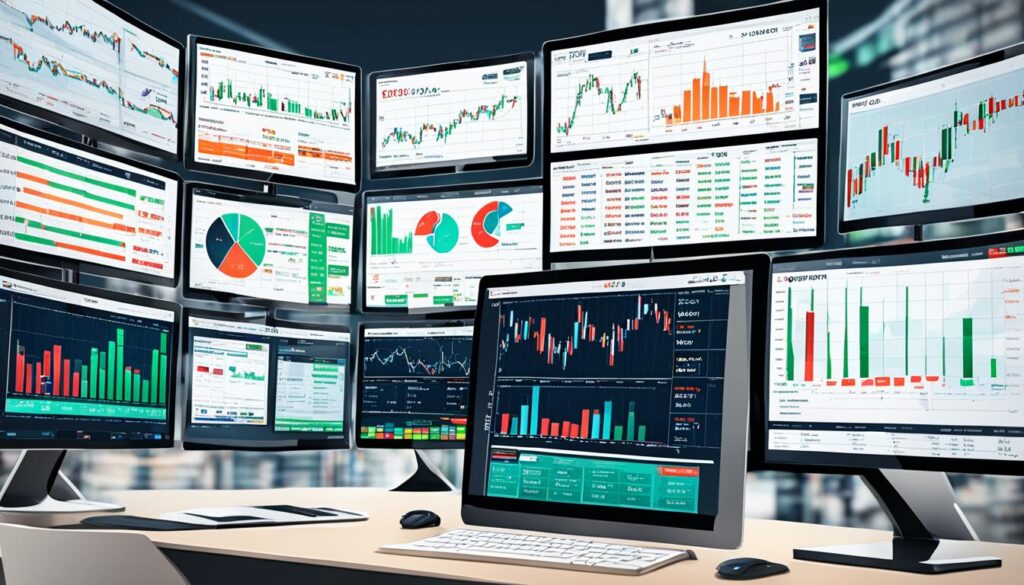Opening a Forex Trading Account: Beginner’s Guide
Every day, the global Forex market trades over $6 trillion. This amount shows how much opportunity there is in trading currencies. If you’re new and want to start trading, learning how to open a Forex trading account for beginners is the first big step. This guide will help you pick a good online Forex broker and figure out complex trading platforms.
At first, opening a currency trading account might seem hard. But, it’s not as difficult as it looks. This guide will explain everything in a simple way. It will help you understand how to start your trading journey. You might be interested because of the high liquidity or the flexible trading hours. Both offer a lot of benefits and chances for you.
Key Takeaways
- Forex market trades over $6 trillion daily, offering ample opportunities for profit.
- Knowing how to open a Forex trading account for beginners is the first step in entering the market.
- Selecting the right online Forex broker is essential for a smooth trading experience.
- Understanding the basics will ease your transition into the world of currency trading.
- Proper guidance can turn the complexities of Forex trading into simple, actionable steps.
Introduction to Forex Trading
The Foreign Exchange, or Forex, is the world’s biggest financial market. It has a daily trading volume over $6 trillion. This market lets people from all over the world trade different currencies. If you learn the forex market basics, you can make the most of its profit potential.
What is Forex Trading?
Forex trading is about buying and selling currency pairs like EUR/USD or GBP/JPY. It happens over the counter, which means trades aren’t through a central place. This free-flowing process connects traders directly. If you’re new to forex trading for beginners, starting with a solid currency trading account is key. Also, getting to know the market’s language and workings is important.
Why Trade in Forex?
Here’s why many people choose the Forex market:
- Liquidity: It’s the most liquid market, so it’s easy to buy and sell whenever.
- 24/7 Trading: You can make trades any time from Monday to Friday, fitting with different time zones.
- Leverage Options: Brokers offer leverage, which lets traders control big positions with less money.
If you’re a forex trading for beginners, knowing these advantages helps. They guide you in setting up achievable goals and plans. Trying a demo account first is wise. It helps you learn risk-free.
Choosing the Right Online Forex Broker
Choosing the right online forex broker is key for any trader. The best one can boost your trading success greatly. You need to look at their reputation, the quality of their trading tools, and their customer service closely.
Reputation and Reviews
It’s crucial to research the forex broker’s reputation. Read lots of reviews to see what others say. A good broker will have many positive reviews. This gives you confidence in your choice.
Trading Platforms and Tools
A great trading platform makes a big difference. Choose brokers with top-notch tools, like real-time data and advanced charts. These features help you make smart trading choices.
Customer Support
Excellent customer service is a must for traders. Pick a broker with fast and helpful support. This means having options like live chat, email, and phone support available. Quick solutions to your problems are crucial during trading.

| Criteria | Details |
|---|---|
| Reputation | Check multiple broker reviews and trader feedback |
| Trading Tools | Look for advanced charting and analysis tools |
| Customer Support | Ensure multi-channel support for quick resolutions |
How to open a Forex trading account for beginners
Opening a Forex trading account is easy if you do it right. Just follow the steps and get all needed info together. Doing this makes sure you start trading well.
Steps to Register Your Account
- Choose a reliable broker, ensuring they are reputable and well-reviewed.
- Visit the broker’s website and locate the open Forex account option.
- Complete the online application, providing accurate personal details.
- Submit identification documents as required for verification.
- Fund your account, meeting the minimum deposit requirements set by the broker.
What Information is Required?
To set up your account, you’ll need to provide:
- Full name and address
- Date of birth
- Contact details (email and phone number)
- Social security number or other identification number
- Financial information such as annual income and net worth
It’s really important to give all the correct information. This helps the registration process go smoothly.
Common Mistakes to Avoid
When starting a Forex account, watch out for these mistakes:
- Incomplete documentation: Make sure you send in all needed documents.
- Inaccurate information: Check the details you put in to avoid any problems later.
- Ignoring broker reviews: Look at what others say about brokers. This can help you avoid bad or fake ones.
Take care and follow these tips. This way, setting up your account will be simple. Then, you can focus on trading well.
Understanding Forex Trading Platforms
Choosing the right forex trading platform is key when you start. MetaTrader is a top choice, famous for being easy to use and powerful. It offers versions like MT4 and MT5. These help traders at every level improve their strategies.

When picking a platform, look for certain features to match how you trade. These features should:
- suit your style and needs
- help you easily navigate
- offer advanced analysis tools
- process orders fast and reliably
- let you use automated trading
A good forex trading platform that works with automated trading software can make your life easier. MetaTrader is excellent for this, making trading smoother with its EA support.
| Platform | Main Features | Best For |
|---|---|---|
| MetaTrader 4 (MT4) | User-friendly interface, robust charting tools, EAs for automated trading | Beginners and Intermediate Traders |
| MetaTrader 5 (MT5) | Advanced charting and trading tools, greater order flexibility, built-in economic calendar | Experienced Traders and Professionals |
Your decision on a forex platform can really impact how well you trade. Both MT4 and MT5 have a lot of features. They focus on helping you trade better in the changing forex market.
Exploring Forex Account Types
When you start in Forex, picking the right account types is key. Choose ones that match your trading goals and how much you’ve traded. There are many types, like standard and mini accounts, plus the forex trading demo account. These work for beginners as well as expert traders.
Standard Accounts
Standard accounts suit traders with a lot to invest. They offer more trading tools and resources. Because of this, you get higher leverage and better spreads. You can also trade bigger lots, for bigger wins or losses.
Mini and Micro Accounts
Mini and micro accounts are for those with less capital. They created mini accounts for smaller risk management. Micro accounts allow even tinier lot sizes, just right for new traders. This lets them explore trading without a big financial risk.
Demo Accounts
A forex trading demo account lets beginners practice without using real money. It’s like real trading but without the risk. This helps you learn and test your trading strategies. It’s a great way to gain confidence before trading live.
| Account Type | Lot Size | Capital Requirement | Suitable For |
|---|---|---|---|
| Standard Account | Full-sized lots | Higher | Experienced Traders |
| Mini Account | Mini lots | Moderate | Intermediate Traders |
| Micro Account | Micro lots | Lower | Beginner Traders |
| Demo Account | N/A | None | All Levels |
It’s crucial to understand the account types, like standard and mini accounts, and use a forex trading demo account for Forex success. Each account type meets specific trader needs. They’re all about helping you improve your trading.
Trading Capital Requirements
When you start Forex trading, knowing the right financial setup is key. You must understand the trading capital requirements. These are crucial for managing risk and aiming for big wins. Let’s dive into these basics to help you begin trading Forex with confidence.

Minimum Deposits
Starting with a minimum deposit is one of your first steps in Forex. Brokers set these to make sure you have enough money for losses and can keep trading. The amount needed changes, from $50 to thousands, based on the broker’s rules and your account type.
Finding a broker that fits your budget and supports your trading needs is crucial.
Leverage and Margin
Leverage in trading means you can control bigger trades with less of your own money. For example, a 1:100 leverage lets you trade $10,000 with just $100. Remember, while it boosts gains, it can also increase losses. Use it wisely.
Margin trading is when you borrow money from your broker to trade. The margin acts as your security for these trades. Knowing how leverage and margin work with your strategy helps manage risks. This is important for doing well in Forex over time.
TPT Forex and CopyTrading
In the vast world of Forex trading, TPT Forex stands out as a powerful tool. It works hand in hand with TPT CopyTrading, giving traders the means to succeed financially. By using automated trading, your experience can be enhanced, leading to more profits.
What is TPT Forex?
TPT Forex is a cutting-edge trading platform with advanced tools. These help traders deal with the often complicated world of Forex trading. It’s designed to be easy to use, with clear interfaces and deep analytics for both new and experienced traders.
What’s unique about TPT Forex is that it focuses on using automated trading. This means your trades can follow market trends and be done with little direct action by you.
How Does CopyTrading Work?
CopyTrading lets you copy the trades of skilled traders automatically. Let’s look at how it works:
- Selection of Traders: Pick traders to follow based on how well they perform and their trading methods.
- Automatic Execution: Once you’ve chosen traders, their actions copy straight to your account in real time.
- Risk Management: TPT CopyTrading also includes strong risk tools. These let you set limits and change settings to fit how much risk you’re comfortable with.
By using CopyTrading, access to high-end trading is opened up. This is not just for experts but also for those learning. It allows new traders to learn by watching and following what seasoned experts in the market do.
When you combine TPT CopyTrading with automated strategies, your trading becomes smoother. You don’t have to spend a lot of time analyzing markets.
If you’re aiming to get the most out of TPT Forex, pairing it with TPT CopyTrading can be a big plus. It’s an efficient way to seize market chances with less risk. With this combo, you’re not facing the Forex market alone. You get guidance from successful traders and the latest in automated trading.
Forex Account Funding Options
Starting forex trading means knowing how to fund your account. We’ll look at common ways to do this, from what’s fast to what’s safe.

Bank Transfers
A bank wire transfer is a classic way to fund your Forex account. It’s known for being secure but can be slow. The time it takes to transfer can vary and might need a few days to complete.
Credit and Debit Cards
Many people use credit cards for easy, quick funding. It’s almost instant, letting you trade right away. Brokers usually accept cards like Visa or MasterCard, so it’s a simple option for most traders.
Electronic Payment Methods
For a more modern choice, there are e-wallets. Services such as PayPal, Skrill, and Neteller are easy to use and fast. If speed and ease matter most to you, e-wallets are a great option.
| Method | Speed | Security | Convenience |
|---|---|---|---|
| Bank Wire Transfer | Slow | High | Moderate |
| Credit Card Deposits | Instant | High | High |
| E-Wallets | Instant | Medium | High |
Picking the best funding method is up to you and what you value. You can go the secure route with a bank wire transfer, enjoy the swiftness of credit card deposits, or choose the modern touch of e-wallets. See what fits your trading style and needs best.
Forex Trading Education for Beginners
Forex trading education is key for anyone wanting to dive into foreign exchange. Knowing the basics leads to a strong trading future. It’s about more than just making deals. It’s about learning market trends and making solid plans.
Start with help from online trading courses, webinars, and mentoring. They teach important things like analyzing markets, managing risks, and staying confident. Here are some good ways to learn about forex trading:
| Resource | Description |
|---|---|
| Online Trading Courses | Structured programs that cover everything from the basics to advanced trading strategies. |
| Webinars | Live sessions led by experts where you can ask questions and engage in real-time. |
| Mentoring | Personalized guidance from experienced traders to help you hone your skills. |
| Books | Comprehensive guides that offer in-depth knowledge on various aspects of forex trading. |
| Forums and Community Groups | Platforms where you can discuss strategies and share tips with fellow traders. |
Companies like TPT Forex offer tools like CopyTrading. It lets new traders copy top traders’ moves. This speeds up learning and offers real-life lessons.
Using these learning tools, you can make strong trading plans. And, your confidence will grow in the market. Always keep learning to excel in forex trading.
Conclusion
Starting in the Forex market can be thrilling and fulfilling. This guide has taken you through the basics to kickstart your Forex trading. You’ve learned about choosing the best broker and how to set up your account.
It’s important to keep learning and make smart choices. Use tools like TPT Forex and TPT CopyTrading to make trading better and more profitable. Stay up-to-date with market trends and get more education and support if you need it.
With the tips and strategies shared here, you’re ready to face the challenges of Forex trading. Be steady and wise in your moves. These will lead you to success in the Forex world. Good luck with your trading journey!
